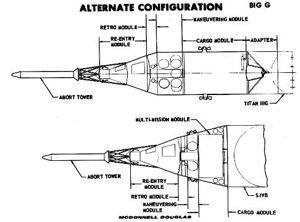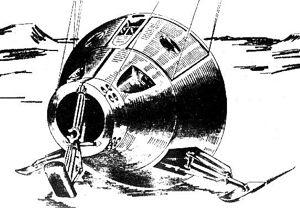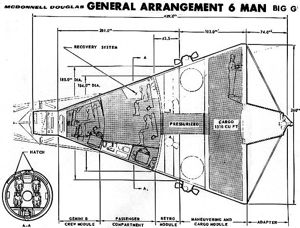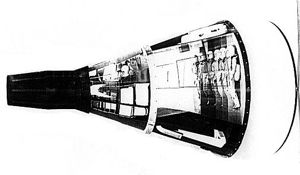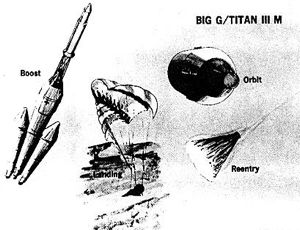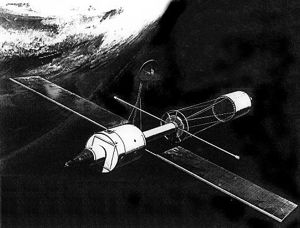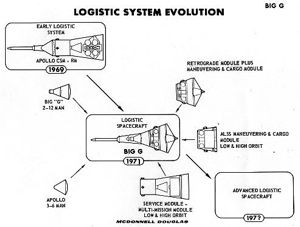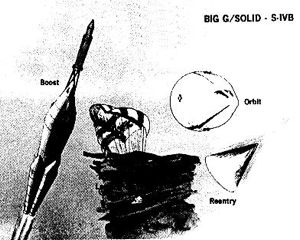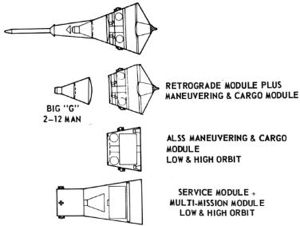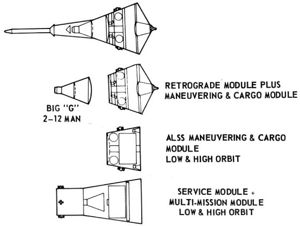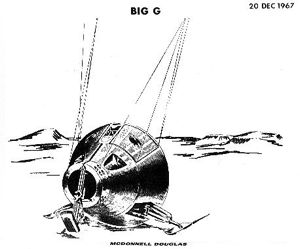
Home - Search - Browse - Alphabetic Index: 0- 1- 2- 3- 4- 5- 6- 7- 8- 9
A- B- C- D- E- F- G- H- I- J- K- L- M- N- O- P- Q- R- S- T- U- V- W- X- Y- Z
Big Gemini
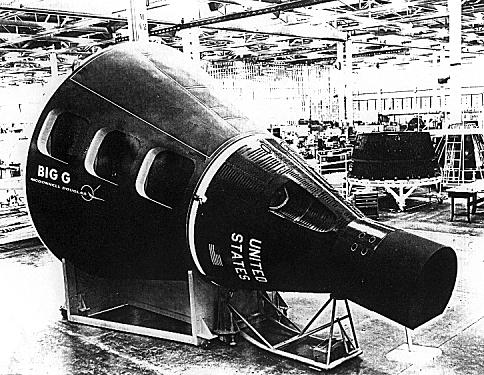
Big Gemini Mockup
Mock-up of the Big Gemini re-entry module on display at the McDonnell plant, St Louis, in 1967. The large windows allowed viewing of the interior of the mock-up and were not going to be part of the flight version! By simply adding a passenger compartment behind the basic Gemini B, McDonnell produced a ballistic re-entry vehicle with the same total mass and base diameter as the Apollo Command Module, but over twice the cargo capacity.
Credit: McDonnell Douglas
Status: Mock-up 1967. Payload: 2,500 kg (5,500 lb). Gross mass: 15,590 kg (34,370 lb). Height: 11.50 m (37.70 ft).
Big Gemini ('Big G') was proposed by McDonnell Douglas to the US Air Force and NASA in 1967 as a ballistic manned orbital logistics spacecraft to provide economical resupply of planned military and civilian space stations.
By the end of 1966 NASA's Gemini program was nearing its conclusion and the design phase of the USAF Manned Orbiting Laboratory (MOL) project was nearly finished. McDonnell-Douglas had a large manned spacecraft engineering team, built up over eight years on the Mercury, Gemini, and MOL programs that was facing dissolution. At the same time both USAF and NASA had funded space station projects. The USAF's MOL and the NASA's Apollo Applications Program Orbital Workshop (later Skylab) were to fly in 1969-1974. Both USAF and NASA were planning even larger follow-on stations - the USAF LORL and NASA MORL.
The capability of existing spacecraft (Apollo CSM, Gemini) for manned resupply missions to these stations was severely limited. In the 1970-1980 period, it appeared that at least a dozen launches would be required for logistics purposes for the Apollo Applications Program alone. MOL and the AAP workshop would require 3 to 6 flights a year, each flight delivering a crew of two or three, with 1 to 7 metric tons of cargo being sent up and up to 0.6 cubic meters of cargo being returned. Planned late 1970's stations would have crews of 6 to 24, requiring a resupply craft that could deliver up to 12 passengers and 12 metric tons of payload 6 to 14 times a year, returning up to 7 cubic meters of cargo each time. Big G could provide such a capability by 1971, using Gemini technology applied to Gemini and Apollo hardware, with minimum interference to the higher priority Apollo lunar landing program.
McDonnell Douglas conceded that the initial flights to Orbital Workshop 1 (then planned for 1970) would have to be supported by the Apollo CSM. However Big G could be available in 1971 to provide improved crew and cargo versatility for Orbital Workshop 2 and USAF MOL resupply.
Big G would consist of the following modules:
- Launch escape tower - the LES developed for the Apollo program would be used for Big-G.
- Big G re-entry module - This was based on the Gemini B re-entry module developed for the USAF MOL program. The Gemini B's fully integrated flight cockpit, environmental control system, and electronic system installations would be retained. However the Gemini B re-entry module conical structure would be extended to 154 inches (3.91 m) diameter (the same as the Apollo service module) to provide a large passenger compartment. This compartment could accommodate up to ten additional passengers or a mix of passengers and cargo - a capacity over twice as great as the Apollo command module at the same total re-entry vehicle mass. The standard configuration proposed for NASA had a crew of six plus substantial cargo return capability. The environmental control system for the passengers and the communication system were located under the floor of the passenger compartment. The existing hatch in the Gemini-B bulkhead would be retained to allow the pilot and co-pilot access to the passenger compartment.
- Retrograde module - This module, tapering from 154 inches to 180 inches (4.57 m) diameter at its base, would house the solid fuel de-orbit rocket motors, separation rockets, and water and oxygen supplies.
- Maneuvering and cargo module - This module included propulsion for orbital maneuvering, electrical power, pressurized and unpressurized volumes for cargo, a pressurized pass-through tunnel, an Apollo docking probe assembly, and a control station for controlling the docking maneuver. Unlike Gemini or Apollo, Big G would dock by its aft end with the space station (the same approach was used in the Soviet TKS resupply spacecraft). This module would vary greatly in size and mass according to the launch vehicle used. In the USAF configuration the maneuvering and cargo module was cylindrical and 180 inches in diameter, for mating to the planned Titan 3G launch vehicle. A truncated version with less than a tenth of the payload could be used with the MOL Titan 3M booster. For NASA use the module was conical, flaring to 260 inch (6.61 m) diameter for mating to the S-IVB upper stage of a Saturn INT-20 or Solid motor/S-IVB launch vehicle.
It was possible to transfer crew and cargo from Big-G to the space station without extra-vehicular activity. A pressurized tunnel led from the passenger compartment to the cargo area, and another tunnel to the docking probe.
Big G used the "packaged return capability" of the Gemini-B. This included "sealed-until-needed" oxygen supply, RCS system, and retrograde and separation motors. These features, compared to Apollo, improved crew safety by assuring the spacecraft could endure extended in-orbit quiescent storage while docked to the space station.
As another alternative (obviously not favored by McDonnell Douglas) the Big G re-entry capsule could be used with an Apollo Service Module and the Apollo Applications Program Multi-Mission Module (a palletized cargo carrier mounted, like the Lunar Module, behind the SM, with which Big G would have to dock and extract from the spent booster).
Total mass of the Big G would depend on the launch vehicle. The Titan 3M version would total 15,600 kg, delivering 9 crew and 2,500 kg of supplies to MOL in a 480 km, 50 degree inclination orbit. The NASA INT-20 version weighed 47,300 kg and could deliver 9 crew and 27,300 kg of payload to the same orbit. The Titan 3G configuration would have an orbital insertion mass of 59,000 kg in a 28.5 degree, 150 x 220 km orbit.
McDonnell's sales pitch was summarized as follows:
- NASA needed an economical logistics vehicle for the Apollo Applications Program
- USAF was interested in a similar logistics vehicle for MOL
- Both NASA and USAF had studies in work for advanced logistics systems for the late 1970's (ILRV - this would eventually become the space shuttle), but nothing existed for the early to late 1970's flights
- A modified Apollo or Big G were the only logical contenders for the role
- Big G was preferable to a modified Apollo because:
- Big G would not interfere with the high-priority lunar program
- Big G could more economically accomplish projected AAP logistics requirements by utilizing existing developed equipment
- Big G could be developed on a cost-sharing basis by NASA and USAF together, reducing costs to both Agencies and providing equipment commonality
- Big G would utilize an experienced, available, and successful industrial team
Big G was not to be. Even at the time the concept was originated both NASA and USAF manned space projects were being cut back. Within 18 months, MOL would be cancelled, and AAP would be limited to using only spacecraft and boosters surplus to the moon landing program. Soon thereafter the shuttle became the only funded space project for the 1970's, and all space station work was abandoned. The Gemini spacecraft - and the American push to rapidly exploit the cosmos - were dead.
Crew Size: 9. Habitable Volume: 18.70 m3.
Family: Manned spacecraft, Space station orbit. People: McDonnell. Country: USA. Spacecraft: Big Gemini AM, Big Gemini CM, Big Gemini RV. Launch Vehicles: Titan, Saturn I. Bibliography: 207, 208, 210, 6387.
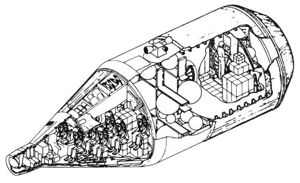 | Big Gemini Credit: NASA |
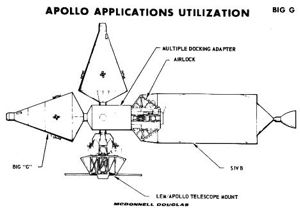 | Big Gemini / OWS Use of Big Gemini as a more cost-effective manned logistics vehicle for use with the Apollo Applications Orbital Workshop (eventually Skylab). Credit: McDonnell Douglas |
1969 August 21 - .
- McDonnell Douglas Corporation, under contract to MSC, submitted an eight-volume final report on a "Big G" study. - .
Nation: USA.
Spacecraft Bus: Gemini.
Spacecraft: Big Gemini.
McDonnell Douglas Corporation, under contract to MSC, submitted an eight-volume final report on a "Big G" study. Three features of the McDonnell Douglas 'Big G' study, performed under contract to MSC, are shown here. For additional information on the proposed system, see the 21 August 1969 entry. Graphics supplied by McDonnell Douglas. The study was performed to generate a preliminary definition of a logistic spacecraft derived from Gemini that would be used to resupply an orbiting space station. Land-landing at a preselected site and refurbishment and reuse were design requirements. Two baseline spacecraft were defined: a nine-man minimum modification version of the Gemini B called Min-Mod Big G and a 12-man advanced concept, having the same exterior geometry but with new, state-of-the-art subsystems, called Advanced Big G. Three launch vehicles-Saturn IB, Titan IIIM, and S-IC/S- IVB-were investigated for use with the spacecraft. The Saturn IB was discarded late in the study. The spacecraft consisted of a crew module designed by extending the Gemini B exterior cone to a 419-cm-diameter heat shield and a cargo propulsion module. Recovery of the crew module would be effected by means of a gliding parachute (parawing). The parametric analyses and point design of the parawing were accomplished by Northrop- Ventura Company under a subcontract, and the contents of their final report were incorporated into the document. The landing attenuation of the spacecraft would be accomplished by a skid landing gear extended from the bottom of the crew module, allowing the crew to land in an upright position. The propulsion functions of transfer, rendezvous, attitude control, and retrograde would be performed by a single liquid-propellant system, and launch escape would be provided by a large Apollo-type escape tower. In addition to the design analyses, operational support analyses and a program development plan were prepared. The summary report acknowledged the cooperation of NASA Centers and companies that provided technical assistance during the study. Principal contributors were MSC, MSFC, KSC, AC Electronics Division of General Motors Corporation, Bell Aerosystems Company, Collins Radio Company, IBM's Federal Systems Division, Kollsman Instrument Corporation, Amecom Division of Litton Systems, Inc., The Marquardt Corporation, Denver Division of Martin Marietta Corporation, Government Electronics Division of Motorola Corporation, Rocketdyne Division of North American Rockwell Corporation, Space Craft, Inc., Science and Technology Division of TRW Systems Group, and Hamilton Standard System Center of United Aircraft Corporation.
Back to top of page
Home - Search - Browse - Alphabetic Index: 0- 1- 2- 3- 4- 5- 6- 7- 8- 9
A- B- C- D- E- F- G- H- I- J- K- L- M- N- O- P- Q- R- S- T- U- V- W- X- Y- Z
© 1997-2019 Mark Wade - Contact
© / Conditions for Use
